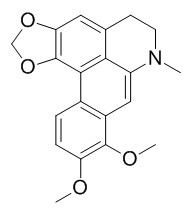Dehydrocrebanine
Dehydrocrebanine has strong activity against promyelocytic leukemia cells (HL-60) with an IC50 of 2.14 ug/mL. It also shows potent antimalarial activity with an IC50 value of 70 ng/ml.
Inquire / Order:
manager@chemfaces.com
Technical Inquiries:
service@chemfaces.com
Tel:
+86-27-84237783
Fax:
+86-27-84254680
Address:
1 Building, No. 83, CheCheng Rd., Wuhan Economic and Technological Development Zone, Wuhan, Hubei 430056, PRC
Providing storage is as stated on the product vial and the vial is kept tightly sealed, the product can be stored for up to
24 months(2-8C).
Wherever possible, you should prepare and use solutions on the same day. However, if you need to make up stock solutions in advance, we recommend that you store the solution as aliquots in tightly sealed vials at -20C. Generally, these will be useable for up to two weeks. Before use, and prior to opening the vial we recommend that you allow your product to equilibrate to room temperature for at least 1 hour.
Need more advice on solubility, usage and handling? Please email to: service@chemfaces.com
The packaging of the product may have turned upside down during transportation, resulting in the natural compounds adhering to the neck or cap of the vial. take the vial out of its packaging and gently shake to let the compounds fall to the bottom of the vial. for liquid products, centrifuge at 200-500 RPM to gather the liquid at the bottom of the vial. try to avoid loss or contamination during handling.
World J Mens Health.2019, 10.5534
Semyung University2017, 149407
J Plant Biochem.Biotech.2024, 33:353-366.
J Food Sci Technol.2022, 59(1):212-219.
Molecules.2020, 25(18):4283.
Phytomedicine.2022, 100:154058.
Journal of Plant Growth Regulation2022, 10705-2.
Indian J Pharm Sci.2024, 86(2):736-741.
J of Archaeological Science:Reports2024, 53:104298
Sci Rep.2024, 14(1):3684.
Related and Featured Products
Planta Med. 2011 Sep;77(13):1519-24.
Cytotoxic and antimicrobial activities of aporphine alkaloids isolated from Stephania venosa (Blume) Spreng.[Pubmed:
21305448]
METHODS AND RESULTS:
The cytotoxic activity of five alkaloids, namely 4,5-dioxo-Dehydrocrebanine (1), Dehydrocrebanine (2), crebanine (3), oxostephanine (4), and thailandine (5) isolated from the tuber and leaves of Stephania venosa (Blume) Spreng was investigated.
CONCLUSIONS:
Thailandine showed the strongest activity against lung carcinoma cells (A549) (IC50 of 0.30 µg/mL) with very low cytotoxicity against normal embryonic lung cells (MRC-5). Thailandine also demonstrated strong activity against Plasmodium falciparum, K1 strain (IC50 of 20 ng/mL), and Mycobacterium tuberculosis H(37)Ra (MIC of 6.25 µg/mL) as well as gram-positive bacteria such as Streptococcus pneumoniae and Staphylococcus aureus. Oxostephanine exhibited strong activity against breast cancer (BC) and acute lymphoblastic leukemia cells (MOLT-3) with an IC50 of 0.24 and 0.71 µg/mL, respectively, and exhibited very low cytotoxicity against MRC-5 cells. Dehydrocrebanine demonstrated strong activity against promyelocytic leukemia cells (HL-60) with an IC50 of 2.14 µg/mL whereas crebanine showed weak activity against cancer cell lines. However, both of them showed cytotoxicity against MRC-5 cells.
Planta Med. 1999 Dec;65(8):754-6.
Antimalarials from Stephania venosa, Prismatomeris sessiliflora, Diospyros montana and Murraya siamensis.[Pubmed:
10630122 ]
METHODS AND RESULTS:
Fourteen compounds isolated from Stephania venosa, Prismatomeris sessiliflora, Diospyros montana and Murraya siamensis were tested for their antimalarial potential.
CONCLUSIONS:
The 6a,7-dehydroaporphine alkaloids dehydrostephanine and Dehydrocrebanine showed potent activity with IC50 values of 40 and 70 ng/ml, respectively. The 13C-NMR data of rubiadin, rubiadin-1-methyl ether, diospyrin and 5-hydroxy-4-methoxy-2-naphthal-dehyde were extensively studied.
J Asian Nat Prod Res. 2016 Nov;18(11):1042-56.
The first total syntheses of (±)-norphoebine, dehydrophoebine, oxophoebine, dehydrocrebanine, oxocrebanine and uthongine and their cytotoxicity against three human cancer cell lines.[Pubmed:
27146697 ]
METHODS AND RESULTS:
The first total syntheses of (±)-norphoebine, dehydrophoebine, oxophoebine, Dehydrocrebanine, oxocrebanine and uthongine have been achieved. The crucial step involved the formation of ring C by a microwave-assisted direct biaryl coupling to produce the aporphine skeleton in high yields. The synthetic alkaloids were evaluated for their cytotoxicity against three human cancer cell lines MCF7, KB and NCI-H187.
CONCLUSIONS:
The results showed that uthongine was the best candidate of the series and it exhibited cytotoxicity against a human breast cancer MCF7 line with an IC50 = 3.05 μM.



